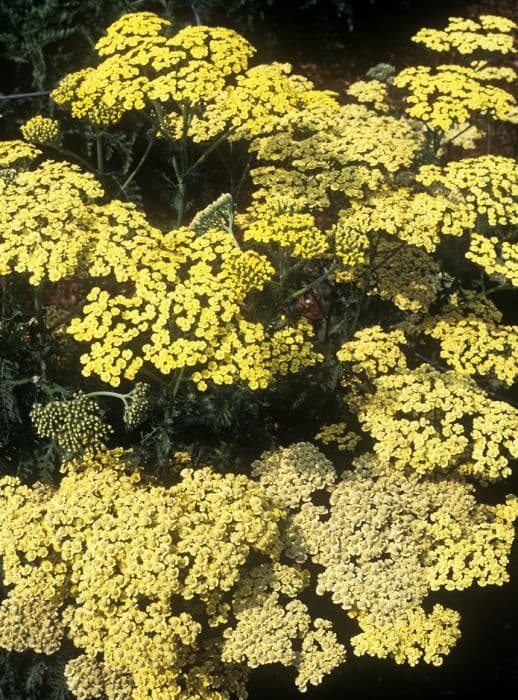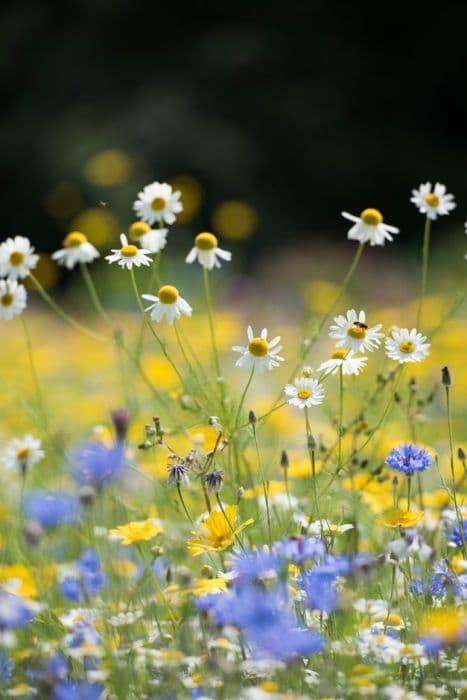Smooth Blue Aster Symphyotrichum laeve 'Orpheus'

ABOUT
The 'Orpheus' variety of the smooth blue aster is a perennial plant known for its attractive foliage and striking flowers. The leaves of this plant are typically smooth and lance-shaped, with a deep green color that can sometimes have a blue or grayish tint. These leaves create a lush backdrop for the real show-stoppers: the flowers. The blooms are daisy-like in form, with a bold yellow center disk that contrasts nicely with the petals. The petals themselves range in color from deep violet to blue, and they radiate around the central disk in a neat, orderly fashion. This combination of yellow centers and bluish petals creates a vibrant and eye-catching display in the garden. The plant is also noted for its hardiness and its ability to attract butterflies and other pollinators to the garden.
About this plant
 Names
NamesFamily
Asteraceae
Synonyms
Smooth Blue Aster, Smooth Aster
Common names
Aster laevis 'Orpheus', Virgulus laevis 'Orpheus'.
 Toxicity
ToxicityTo humans
The Symphyotrichum laeve, commonly known as the smooth blue aster, is not typically considered toxic to humans. However, ingestion of any plant material can potentially cause a reaction in some individuals due to allergies or sensitivities. If there were any toxicity, symptoms would vary depending on the individual's sensitivity, but generally, non-toxic plants might cause mild stomach upset if ingested in large quantities.
To pets
The smooth blue aster is not commonly known to be toxic to pets. If a pet were to ingest part of this plant, it is unlikely to cause serious harm. However, as with humans, individual animals might have sensitivities that could lead to mild gastrointestinal upset such as vomiting or diarrhea. As always, it's best to prevent pets from eating plants since variability in reactions can occur.
 Characteristics
CharacteristicsLife cycle
Perennials
Foliage type
Deciduous
Color of leaves
Green
Flower color
Purple
Height
3 feet 6 inches [1.07 meters]
Spread
2 feet [0.61 meters]
Plant type
Herb
Hardiness zones
4
Native area
North America
Benefits
 General Benefits
General Benefits- Attracts pollinators: Symphyotrichum laeve 'Orpheus', commonly known as Smooth Blue Aster, is known to attract bees and butterflies, which are important for pollination in gardens and ecosystems.
- Adds aesthetic value: With its striking blue to violet flowers, this perennial plant can greatly enhance the visual appeal of a garden or landscape.
- Drought tolerant: Smooth Blue Aster is quite drought-resistant once established, making it an excellent choice for low-water gardens or xeriscaping.
- Provides seasonal interest: Blooming in late summer to fall, it offers color and interest to the garden during a time when many other plants are past their peak.
- Supports wildlife: The plant serves as a food source for various insects and provides habitat, playing a role in local biodiversity.
- Easy to care for: Smooth Blue Aster is generally resistant to pests and diseases, reducing the need for chemical treatments and making it easy to maintain.
- Versatile landscaping: It can be used in borders, wildflower gardens, naturalized areas, or as part of a prairie planting to create diverse garden designs.
 Medical Properties
Medical PropertiesThis plant is not used for medical purposes.
 Air-purifying Qualities
Air-purifying QualitiesThis plant is not specifically known for air purifying qualities.
 Other Uses
Other Uses- Artistic medium: The leaves and flowers of the Smooth Blue Aster can be used for botanical prints or natural dye-making, adding unique patterns and colors to fabrics or paper.
- Garden themes: It's ideal for creating themed gardens, such as 'moon gardens,' where the light-colored flowers glow in the moonlight and 'butterfly gardens,' providing nectar for pollinators.
- Floral arrangements: Fresh or dried, the flowers of the Smooth Blue Aster add a wildflower charm to any bouquet and work well in autumnal flower arrangements.
- Erosion control: The plant can be used on slopes or areas prone to erosion due to its relatively robust root system that helps anchor the soil.
- Photography subject: The striking blue flowers make the Smooth Blue Aster a popular subject for photographers specializing in macro photography or nature scenes.
- Companion planting: The plant can be used as a companion to vegetable gardens, attracting beneficial insects and aiding in pest control.
- Education: The Smooth Blue Aster can be used in educational settings such as schools, to teach children about native plants and the importance of biodiversity.
- Wildlife habitat creation: When planted in larger groups, they can create a mini-habitat offering shelter and food for small wildlife within a larger garden or landscape.
- Fall interest: This plant can be used to extend the visual interest in a garden as many other flowers have finished blooming by the time the Smooth Blue Aster is in its prime.
- Perfumery: While not a traditional use, the subtle scent of the Smooth Blue Aster could inspire natural perfume blends that evoke the essence of late summer and early fall.
Interesting Facts
 Feng Shui
Feng ShuiThe Smooth Blue Aster is not used in Feng Shui practice.
 Zodiac Sign Compitability
Zodiac Sign CompitabilityThe Smooth Blue Aster is not used in astrology practice.
 Plant Symbolism
Plant Symbolism- Hope: The Symphyotrichum laeve 'Orpheus', commonly known as the Smooth Blue Aster, often symbolizes hope due to its late bloom in the season, bringing color and life as other plants begin to fade.
- Patience: As the Smooth Blue Aster blooms late in the year, it represents the virtue of patience, teaching the importance of waiting for the right moment to shine.
- Eternity: Asters have long been associated with the concept of eternity because of their star-like shape, suggesting the vastness of the universe and the timeless nature of the soul.
- Wisdom: In some contexts, asters are connected with wisdom, possibly because of their association with the Greek goddess Asteria, who embodies the prophetic dreams and astrology.
- Love and Devotion: As with many flowers, the Smooth Blue Aster can also be a symbol of love and devotion, indicating a steadfastness and unwavering commitment akin to the persistence of the flower to bloom each year.
 Water
WaterSmooth Blue Aster should be watered deeply but infrequently to encourage strong root growth. Typically, watering to a depth of about 1 inch once a week during the growing season is sufficient. The soil should be allowed to dry out between waterings to prevent overwatering and root rot. This plant is somewhat drought-tolerant once established, so it may require less frequent watering when fully mature. During particularly hot or dry periods, additional water may be necessary. Always adjust watering based on rainfall, as natural precipitation may reduce the need for supplemental watering.
 Light
LightSmooth Blue Aster prefers full sun to partial shade. The best spot for the plant is in an area where it can receive at least 6 to 8 hours of direct sunlight daily. It can tolerate light shade, especially in hot climates, but flowering is best with ample sunlight.
 Temperature
TemperatureSmooth Blue Aster can tolerate a range of temperatures and is hardy in zones 4 through 8. The plant can survive minimum winter temperatures down to about -30°F and is comfortable in typical summer temperatures of about 85°F to 90°F. The ideal growing conditions are within this range, with regular nighttime temperature dips to help promote vigorous growth.
 Pruning
PruningPruning Smooth Blue Aster is important to maintain shape and promote bushier growth with more blooms. Prune in early spring by cutting back last year's growth to about 4 to 6 inches. Additionally, pinching back the tips in late spring can encourage more branching. The best time for pruning is just after new growth appears, generally in early to mid-spring.
 Cleaning
CleaningAs needed
 Soil
SoilSmooth Blue Aster 'Orpheus' prefers well-draining soil with added compost or other organic matter, with a pH range of 6.0 to 7.5 for optimal growth. A mixture of garden soil, compost, and perlite or sand can create the ideal environment for this plant.
 Repotting
RepottingSmooth Blue Aster 'Orpheus' typically does not require frequent repotting and can be done every 2-3 years or when the plant outgrows its current container, to ensure it continues to flourish.
 Humidity & Misting
Humidity & MistingSmooth Blue Aster 'Orpheus' is adaptable to a wide range of humidity levels and can thrive in the average outdoor humidity conditions typical of its native environment.
 Suitable locations
Suitable locationsIndoor
Provide bright light and periodic watering for indoor Smooth Blue Aster.
Outdoor
Plant in full sun to partial shade in well-draining soil for outdoor Smooth Blue Aster.
Hardiness zone
4-8 USDA
 Life cycle
Life cycleThe Symphyotrichum laeve 'Orpheus', commonly known as Smooth Blue Aster, begins its life cycle when seeds germinate in spring, growing into small rosettes of foliage. The plant then enters a vegetative state, where it develops sturdy stems and elongated, lance-shaped leaves throughout the late spring and summer. In late summer to early fall, it reaches the flowering stage, producing clusters of blue to violet flowers with yellow centers that attract pollinators. After pollination, the plant sets seeds in the fall, which are dispersed by wind or wildlife, ensuring the continuation of the species. As winter approaches, the above-ground part of the plant dies back, with the root system remaining dormant until the next spring. The cycle repeats annually, as Smooth Blue Aster is a perennial plant that regrows from the root system each year.
 Propogation
PropogationPropogation time
Late summer
The popular method of propagation for the Smooth Blue Aster (Symphyotrichum laeve 'Orpheus') is via division. This should be done in the spring as new growth appears. To propagate by division, carefully dig up the plant, ensuring a generous amount of root and soil is attached. The clump should then be gently separated into smaller sections, each with its own roots and shoots. These divisions can be immediately replanted in a pre-prepared hole that is as deep as the root ball and twice as wide, giving each new plant ample space to establish. Water the newly planted divisions thoroughly to help them settle into their new location. This method provides a quick and effective way to create new plants that will resemble the parent plant in every aspect.









